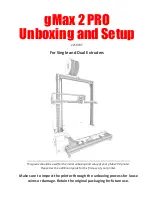
Go to table of contents
DCS_Direct_Jet_1024UVHS_Maintenance_Troubleshooting_Guide_1.2.docx
6 |
P a g e
•
Please read these guidelines before operating your Direct Jet printer.
SAFETY AND PRECAUTIONS
•
Keep all inks, solvents and lubricants out of the reach of children.
•
Use only approved cleaning agents and solvents and then only for the purposes specified in this
guide.
•
Use only genuine Multisolve™ UV-LED inks.
•
Keep inks in a cool, dark and dry location.
•
Inks must be used in opaque cartridges only.
•
This printer produces potentially harmful UV light. Protect eyes and skin from exposure.
•
This printer should be in a well-ventilated area, particularly if used for long periods or in a small
space.
•
Avoid physical contact with the printer's table and print head while the printer is in operation.
•
Avoid dropping items or spilling liquids in or on the printer.
•
Keep hair, jewelry or loose clothing away from the moving parts of the printer.
•
Lifting this printer by hand requires a minimum of two people.
•
Do not attempt to repair this machine yourself without prior DCS authorization. Unless specified
in this guide, only qualified service personnel should attempt any disassembly, repair or access
to internal components. If you need to make mechanical adjustments, turn off your printer and
disconnect it from all power and data sources.
•
Safety Warning: Safety Glasses and gloves should be used whenever filling ink cartridges or
manually cleaning the print head. These symbols will be used throughout this manual as a
reminder to use safety glasses and gloves. Wear protective gear whenever there is
exposure to the inks, regardless of whether a symbol is displayed.
For prolonged exposure, DCS recommends Butyl Black or Ethylene Vinyl Alcohol Copolymer
laminated gloves.
•
The Adhesion Promoter should not be used in an enclosed area without
adequate ventilation. RESPIRATORY PROTECTION: If exposure can exceed the
PEL/TLV, use only NIOSH/MSHA approved air-purifying or supplied air
respirator operated in a positive pressure mode per the NIOSH/OSHA 1981
occupational health guidelines for chemical hazards.
Look for helpful hints.







































